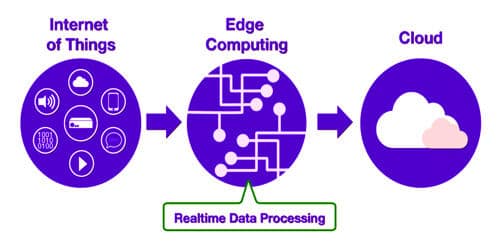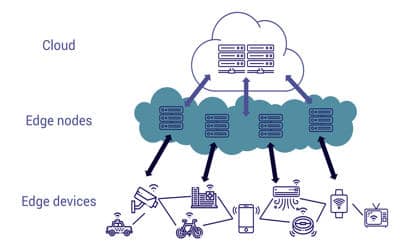Edge Computing – can make easy your life
Edge computing is the most modern technology development that is getting famous by the day. It is the practice of dealing out data near the edge of the network where the data is being generated, as a substitute in a centralized data processing warehouse. The technology is based on the philosophy of bringing computing power as close to the data source. It is a distributed, open IT architecture that features decentralized processing power, enabling mobile computing and Internet of Things (IoT) technologies. This helps in reducing bandwidth and latency. It brings the capabilities of the cloud close to the end-user or end-device. This both reduces costs and ensures that applications can be used efficiently in secluded locations.
In edge computing, data is processed by the device itself or by a local computer or server, rather than being transmitted to a data center. It means the future of software will be managed. The technology aims to run fewer processes in the cloud and shifting those processes to locations such as the user’s system or an edge server. This enables data stream acceleration, including real-time data processing without latency. Bridging this gap between the data and the computation reduces the long-distance communication between the server and the client, which in turn augments the speed of the procedure. It allows smart applications and devices to retort to data almost instantly as its being formed, eliminating lag time. These delays can be avoided altogether by bringing more processes to the network edge.

Fig: The Infrastructure of Edge Computing
This is why edge computing is used for handling time-sensitive data stored in remote locations that have limited connectivity to the central location. This is significant for technologies such as self-driving cars and has similarly essential benefits for business. The technology will make cloud computing and IoT devices faster. It is becoming more and more popular in large systems such as the Internet of Things. For example, if you buy one security camera, you can possibly stream all of its recordings to the cloud.
Common benefits
It helps minimize bandwidth use and server resources. A common business benefit is, companies can accumulate money by having the processing done locally, dropping the amount of data that needs to be processed in a centralized or cloud-based location.
- This reduces the requirement for long-distance communications between client and server, which diminishes latency and bandwidth procedure.
- It decreases in bandwidth use and associated cost and decrease in server resources and related costs.
- For many companies, speed is absolutely vital to their core business. This immediacy to data at its source can convey strong business settlement: faster insights, enhanced response times, and healthier bandwidth accessibility.
- It can help sustain privacy and will adhere to data custody laws and regulations.
- It distributes dispensation, storage, and applications transversely a wide range of devices and data centers, which makes it complicated for any single disturbance to take down the network.

Fig: Common procedure of Edge Computing
Edge computing allocates for proficient data processing in that huge amounts of data can be processed near the source, dropping Internet bandwidth usage. It is estimated that by 2022, the edge computing market will be worth $7 billion. Companies like Amazon, Microsoft, and Google have demonstrated to us that we can trust them with our personal data. The technology will be popular in areas such as healthcare, retail, and manufacturing. It is a physical compute infrastructure that is placed on the range between the device and the hyper-scale cloud, supporting various applications. Thus, it will open the doors to many job opportunities. You can expose new business opportunities, boost operational effectiveness, and present faster, more dependable, and reliable experiences for your customers. It is estimated that the salary range of an Edge computing expert will be around $100,400 to $123,000 per annum. Edge computing would a powerful resource and strategy in the modern data center.















